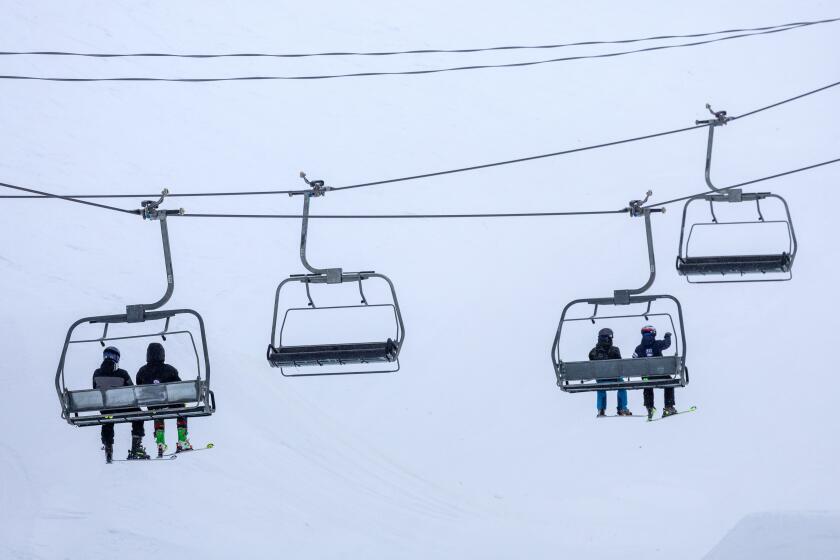Before We Drink to Pure Water . . . : ‘Excellent’ Rating for L.A. Supply Was a Bit of a Fluke
- Share via
The January issue of Consumer Reports magazine brought good news for the Los Angeles Department of Water and Power. In a taste test of several municipal water supplies and a number of bottled waters, samples from Los Angeles were given an “excellent” rating--in fact, the magazine put L.A. water at the top of its list.
After more than a year of media reports that city water is contaminated with traces of toxic chemicals, city officials were obviously delighted. On Dec. 30 at the dedication of the DWP’s new $146-million water-filtration plant in Sylmar, Mayor Tom Bradley, Rick J. Caruso, president of the Board of Water and Power Commissioners, and others drank the upgraded water from wine goblets for the benefit of television cameras. The mayor called the water the “elixir of the Department of Water and Power,” and announced that he was cutting off city employees’ supply of bottled water, which reportedly has been costing more than $150,000 per year. “I now know that there is no excuse, no health reasons, no problem with turbidity, no problem with taste that should require any city employee to have to pay . . . for that kind of drinking water,” the mayor said.
Were the media reports about Los Angeles’ water-quality problems just false alarms? Was it hysteria whipped up by environmental extremists? Unfortunately, the answer is no. Los Angeles gets its water from three separate sources, and, apparently by sheer coincidence, the samples used in the Consumer Reports taste test came from only one of those sources--the one that shows the lowest levels of chemical contaminants.
On a year-round average, 75% of Los Angeles’ water comes from the melting snows of the eastern Sierra Nevada, and travels more than 300 miles via aqueduct. About 13% is pumped from wells tapping underground supplies in the San Fernando Valley, and about 12% currently is being purchased from the Metropolitan Water District, which administers water from the Colorado River and the California Water Project. The aqueduct water is consumed primarily in the San Fernando Valley and West Los Angeles, while the well water is pumped over the Santa Monica Mountains and into the Hollywood, central-city and East Los Angeles areas. The Metropolitan Water District supplements supplies throughout the eastern half of the city, but especially in Northeast Los Angeles and the harbor area.
During the summer, when the snow melt subsides, the majority of supplies to the central and eastern sections of the city are from the wells and the Metropolitan Water District. Over the past several years the well water has shown increasing levels of the toxic chemicals trichloroethylene (TCE) and perchloroethylene (PCE), and the MWD water contains significant levels of trihalomethanes (THMs). These chemicals are classified by the U.S. Environmental Protection Agency as suspected or probable human carcinogens. The situation is considered to be so serious that the EPA has designated the San Fernando Valley as a federal Superfund cleanup site.
According to Steven Feiertag, project leader for the Consumer Reports study, water samples were taken from eight addresses throughout the Los Angeles area. Although all of the samples were put through chemical analysis, only four of them were used for the taste test, which was the sole basis for the rating that was given to Los Angeles water. (And the taste test was performed by only one “sensory consultant.”) Feiertag says that, through pure coincidence, the four samples were entirely aqueduct water--the best that Los Angeles has to offer.
The Consumer Reports article came out at the same time that the city’s water quality is facing a serious threat. Snowfall in the Sierra has been only one-quarter what it was at this time last year. Laurent McReynolds, assistant chief engineer for water at the Department of Water and Power, said that at this point “there’s no question we’re in a drought.” The department’s recent attempts to increase snowfall by cloud seeding are not likely to add more than 5% to the total. If the situation does not turn around soon, the summer months may bring a full-fledged drought. Since the city’s reservoirs carry only a three-month supply, this means that the DWP may be forced to rely on even greater amounts of water from the San Fernando Valley wells and the Metropolitan Water District.
As for the mayor’s decision to cut off the city employees’ bottled water, the desire to trim unnecessary expenditures is laudable, but in this case is largely misdirected. According to DWP figures, 70% to 80% of the water used at City Hall comes from the Valley wells. Thus, little of the “elixir” that the mayor drank last month at the Sylmar filtration plant, which treats only water from the aqueduct, makes it as far as downtown Los Angeles.
The city faces serious water-quality problems, but there is much that still can be done to protect the public health. The new filtration plant is a step in the right direction. City officials need to put down their wine glasses, roll up their sleeves and get on with the hard work of ensuring that all Los Angeles residents receive pure water supplies.
More to Read
Sign up for Essential California
The most important California stories and recommendations in your inbox every morning.
You may occasionally receive promotional content from the Los Angeles Times.










